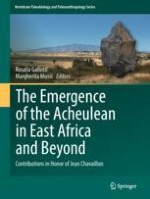2018 | OriginalPaper | Buchkapitel
8. Bifacial Shaping at the TK Acheulean Site (Bed II, Olduvai Gorge, Tanzania): New Excavations 50 Years After Mary Leakey
verfasst von : Manuel Santonja, Susana Rubio-Jara, Joaquín Panera, Alfredo Pérez-González, Raquel Rojas-Mendoza, Manuel Domínguez-Rodrigo, Audax Z. P. Mabulla, Enrique Baquedano
Erschienen in: The Emergence of the Acheulean in East Africa and Beyond
Aktivieren Sie unsere intelligente Suche, um passende Fachinhalte oder Patente zu finden.
Wählen Sie Textabschnitte aus um mit Künstlicher Intelligenz passenden Patente zu finden. powered by
Markieren Sie Textabschnitte, um KI-gestützt weitere passende Inhalte zu finden. powered by
